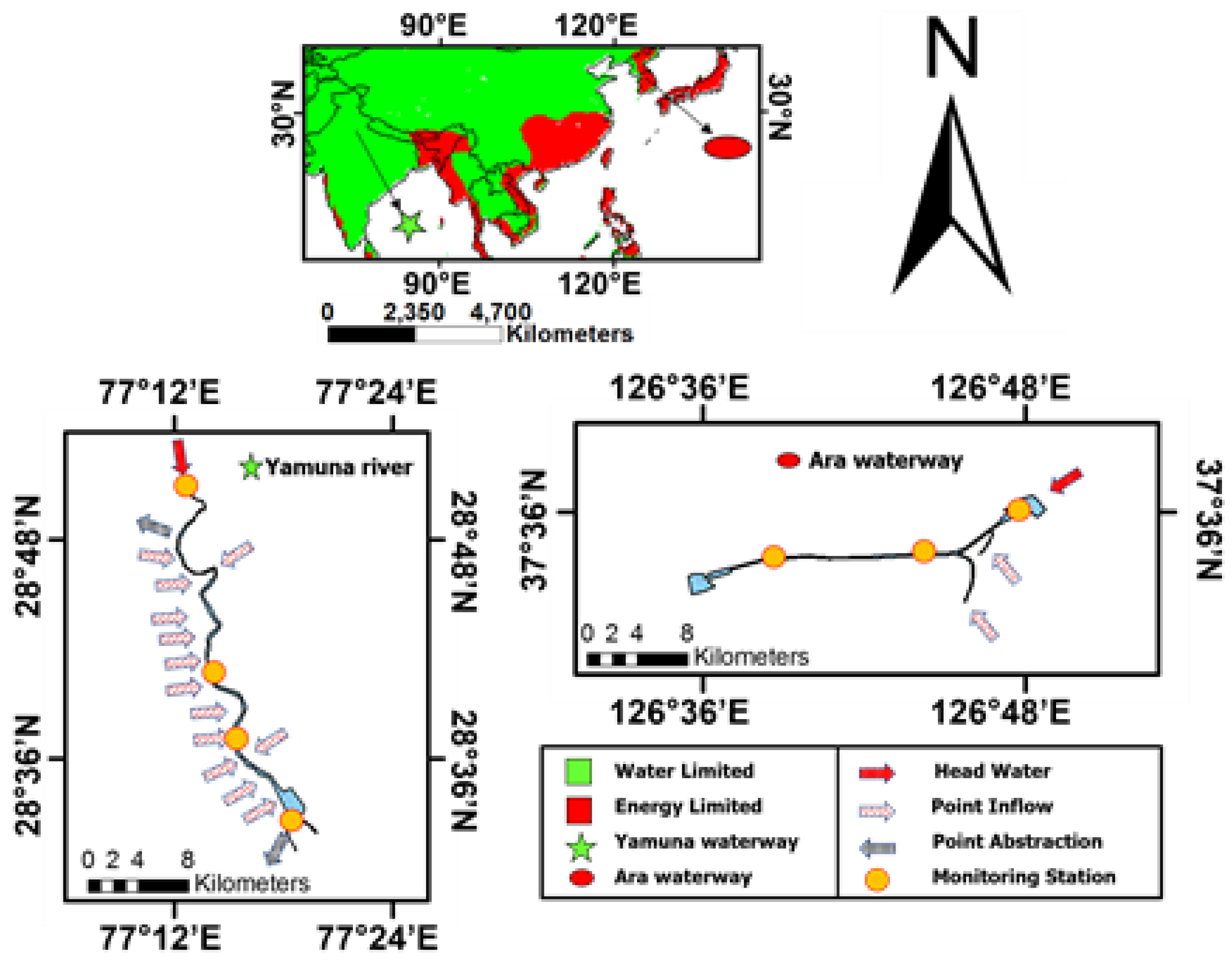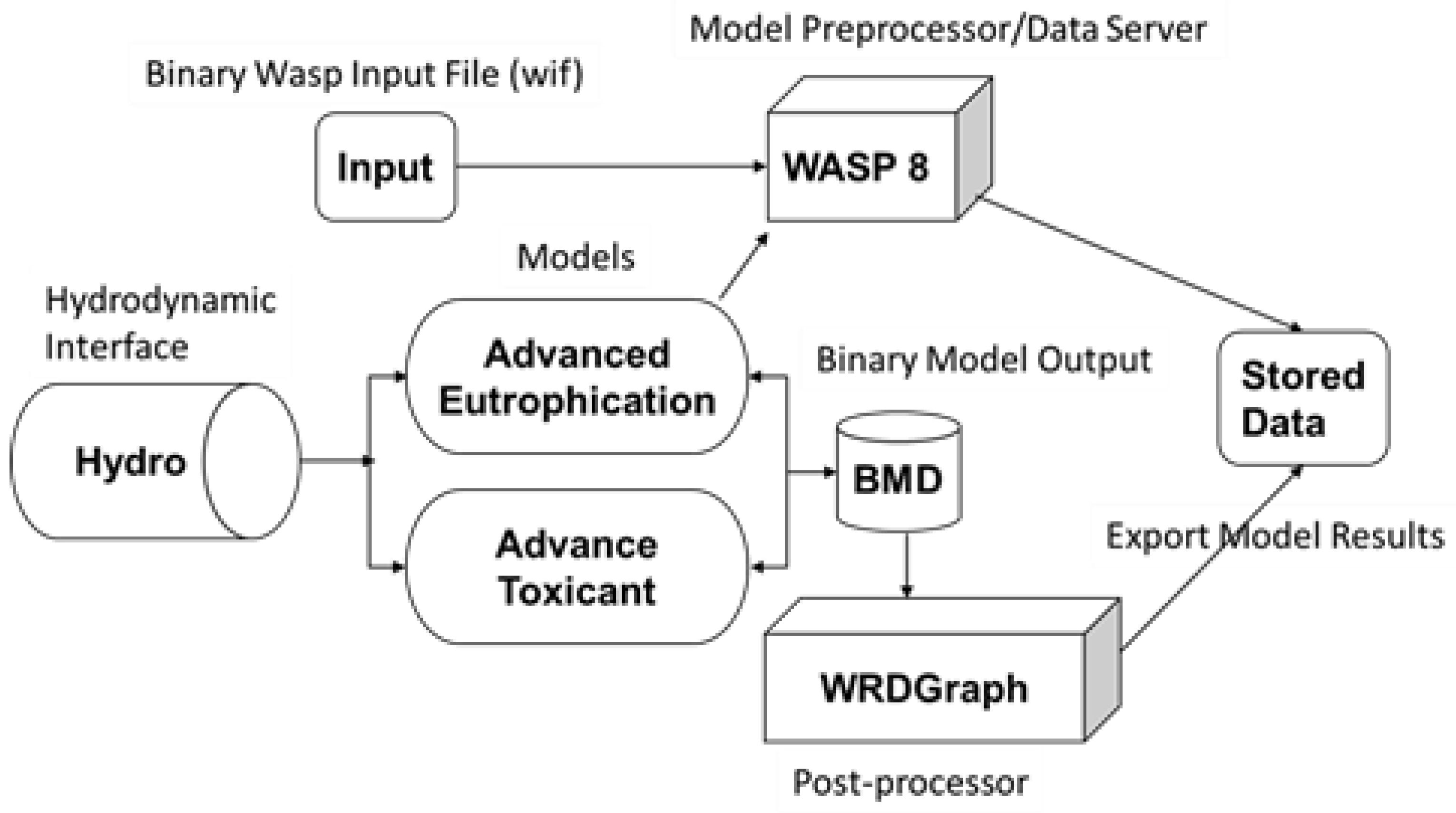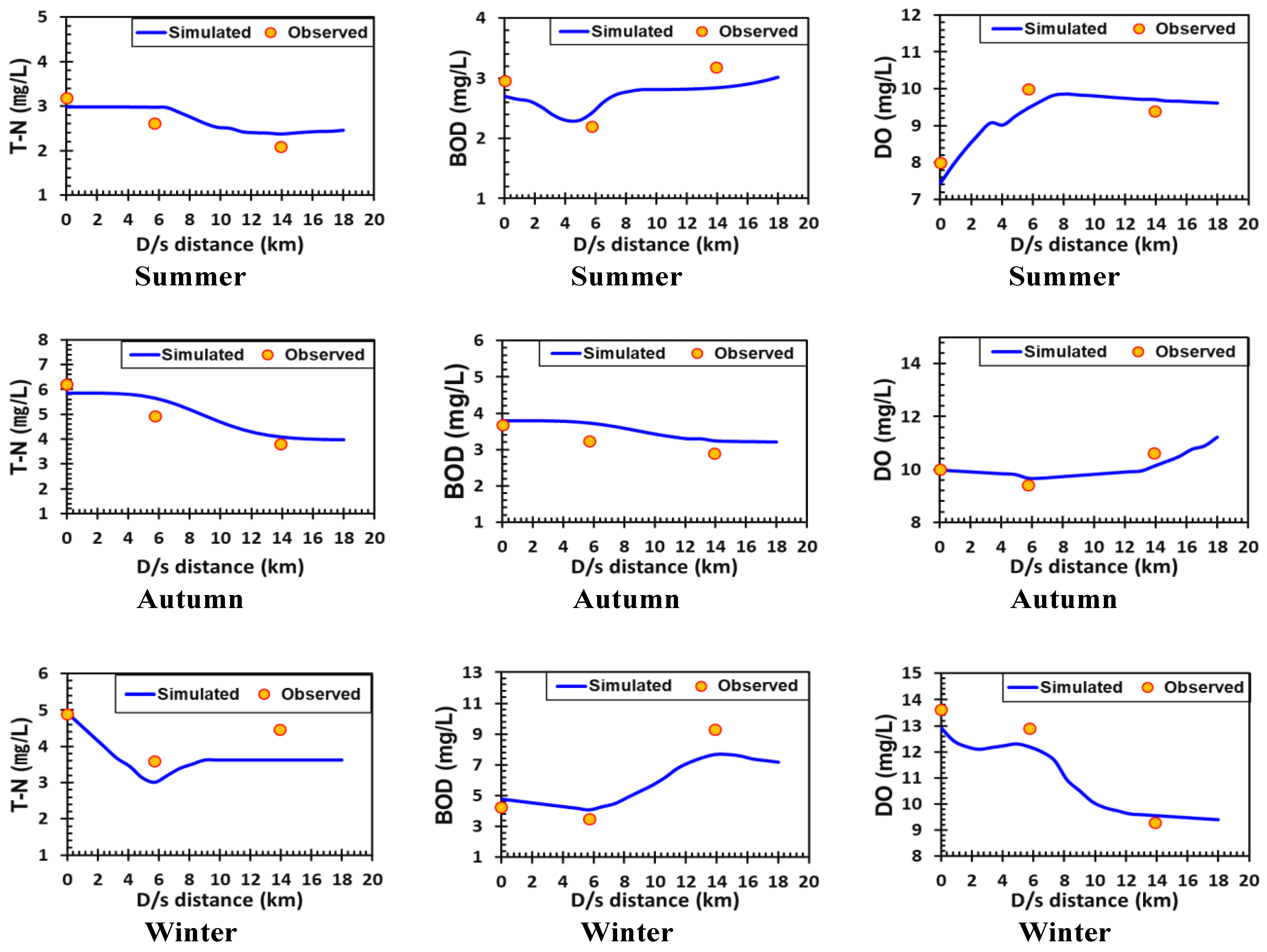Analysis of Seasonal Variations in Surface Water Quality over Wet and Dry Regions
Abstract
:1. Introduction
2. Materials and Methods
2.1. Study Area
2.1.1. The Gyeongin Ara Waterway
2.1.2. The Yamuna River
2.2. Data Set
2.3. Water Quality Modeling
2.4. Vegetation Indices
2.5. Model Accuracy Assesment
3. Results
3.1. Evaluation of the WASP8 Model for Its Reliability
The WASP8 Calibrations and Validations
3.2. Spatial Scale Interrelationship between the Water Quality and Vegetation Indices
3.3. Study Limitation
4. Conclusions
Author Contributions
Funding
Institutional Review Board Statement
Informed Consent Statement
Data Availability Statement
Acknowledgments
Conflicts of Interest
References
- van Vliet, M.T.; Jones, E.R.; Flörke, M.; Franssen, W.H.; Hanasaki, N.; Wada, Y.; Yearsley, J.R. Global water scarcity including surface water quality and expansions of clean water technologies. Environ. Res. Lett. 2021, 16, 024020. [Google Scholar] [CrossRef]
- Schwarzenbach, R.P.; Egli, T.; Hofstetter, T.B.; Von Gunten, U.; Wehrli, B. Global water pollution and human health. Annu. Rev. Environ. Resour. 2010, 35, 109–136. [Google Scholar] [CrossRef]
- Choque-Quispe, D.; Froehner, S.; Palomino-Rincón, H.; Peralta-Guevara, D.E.; Barboza-Palomino, G.I.; Kari-Ferro, A.; Zamalloa-Puma, L.M.; Mojo-Quisani, A.; Barboza-Palomino, E.E.; Zamalloa-Puma, M.M. Proposal of a Water-Quality Index for High Andean Basins: Application to the Chumbao River, Andahuaylas, Peru. Water 2022, 14, 654. [Google Scholar] [CrossRef]
- Alexakis, D.; Gotsis, D.; Giakoumakis, S. Assessment of drainage water quality in pre-and post-irrigation seasons for supplemental irrigation use. Environ. Monit. Assess. 2012, 184, 5051–5063. [Google Scholar] [CrossRef] [PubMed]
- Arora, S.; Keshari, A.K. Dissolved oxygen modelling of the Yamuna River using different ANFIS models. Water Sci. Technol. 2021, 84, 3359–3371. [Google Scholar] [CrossRef] [PubMed]
- Zahraeifard, V.; Deng, Z. VART model–based method for estimation of instream dissolved oxygen and reaeration coefficient. J. Environ. Eng. 2012, 138, 518–524. [Google Scholar] [CrossRef]
- Park, S.S.; Lee, Y.S. A water quality modeling study of the Nakdong River, Korea. Ecol. Model. 2002, 152, 65–75. [Google Scholar] [CrossRef]
- Iqbal, M.M.; Shoaib, M.; Agwanda, P.; Lee, J.L. Modeling approach for water-quality management to control pollution concentration: A case study of Ravi River, Punjab, Pakistan. Water 2018, 10, 1068. [Google Scholar] [CrossRef] [Green Version]
- Khan, R.; Inam, M.A.; Iqbal, M.M.; Shoaib, M.; Park, D.R.; Lee, K.H.; Shin, S.; Khan, S.; Yeom, I.T. Removal of ZnO nanoparticles from natural waters by coagulation-flocculation process: Influence of surfactant type on aggregation, dissolution and colloidal stability. Sustainability 2019, 11, 17. [Google Scholar] [CrossRef] [Green Version]
- Iqbal, M.M.; Shoaib, M.; Farid, H.U.; Lee, J.L. Assessment of water quality profile using numerical modeling approach in major climate classes of Asia. Int. J. Environ. Res. Public Health 2018, 15, 2258. [Google Scholar] [CrossRef] [Green Version]
- Liu, B.; Dong, D.; Hua, X.; Dong, W.; Li, M. Spatial Distribution and Ecological Risk Assessment of Heavy Metals in Surface Sediment of Songhua River, Northeast China. Chin. Geogr. Sci. 2021, 31, 223–233. [Google Scholar] [CrossRef]
- Huang, L.; Bai, J.; Xiao, R.; Gao, H.; Liu, P. Spatial distribution of Fe, Cu, Mn in the surface water system and their effects on wetland vegetation in the Pearl River Estuary of China. CLEAN–Soil Air Water 2012, 40, 1085–1092. [Google Scholar] [CrossRef]
- Wang, Q.; Li, S.; Jia, P.; Qi, C.; Ding, F. A review of surface water quality models. Sci. World J. 2013, 2013, 231768. [Google Scholar] [CrossRef] [PubMed] [Green Version]
- Farid, H.U.; Ahmad, I.; Anjum, M.N.; Khan, Z.M.; Iqbal, M.M.; Shakoor, A.; Mubeen, M. Assessing seasonal and long-term changes in groundwater quality due to over-abstraction using geostatistical techniques. Environ. Earth Sci. 2019, 78, 386. [Google Scholar] [CrossRef]
- Ali, A.; Iqbal, M.; Khattak, K.K. Pilot plant investigation on the start-up of a UASB reactor using sugar mill effluent. Cent. Asian J. Environ. Sci. Technol. Innov. 2020, 1, 199–205. [Google Scholar]
- Cox, B. A review of currently available in-stream water-quality models and their applicability for simulating dissolved oxygen in lowland rivers. Sci. Total Environ. 2003, 314, 335–377. [Google Scholar] [CrossRef]
- Iqbal, M.M.; Shoaib, M.; Agwanda, P.O. The response of pollution load from coastal river waterfront on red tides in South Sea. J. Coast. Res. 2019, 91, 231–235. [Google Scholar] [CrossRef]
- Fan, C.; Ko, C.-H.; Wang, W.-S. An innovative modeling approach using Qual2K and HEC-RAS integration to assess the impact of tidal effect on River Water quality simulation. J. Environ. Manag. 2009, 90, 1824–1832. [Google Scholar] [CrossRef]
- Morley, N.J. Anthropogenic effects of reservoir construction on the parasite fauna of aquatic wildlife. EcoHealth 2007, 4, 374–383. [Google Scholar] [CrossRef]
- Shoaib, M.; Iqbal, M.M.; Khan, R.; Lee, J.L. An Analytical Study for Eutrophication Management of Arawaterway, Korea, by Developing a Flow Model. J. Coast. Res. 2019, 91, 226–230. [Google Scholar] [CrossRef]
- Agwanda, P.O.; Iqbal, M.M. Engineering Control of Eutrophication: Potential Impact Assessment of Wastewater Treatment Plants Around Winam Gulf of Lake Victoria in Kenya. J. Coast. Res. 2019, 91, 221–225. [Google Scholar] [CrossRef]
- Kannel, P.R.; Kanel, S.R.; Lee, S.; Lee, Y.-S.; Gan, T.Y. A review of public domain water quality models for simulating dissolved oxygen in rivers and streams. Environ. Modeling Assess. 2011, 16, 183–204. [Google Scholar] [CrossRef]
- Yang, C.-P.; Kuo, J.-T.; Lung, W.-S.; Lai, J.-S.; Wu, J.-T. Water quality and ecosystem modeling of tidal wetlands. J. Environ. Eng. 2007, 133, 711–721. [Google Scholar] [CrossRef]
- Ambrose, R.B.; Wool, T.A.; Martin, J.L. The Water Quality Analysis Simulation Program, WASP5, Part A: Model Documentation; Environmental Research Laboratory, US Environmental Protection Agency: Athens, GA, USA, 1993.
- Alam, A.; Badruzzaman, A.; Ali, M.A. Assessing effect of climate change on the water quality of the Sitalakhya river using WASP model. J. Civ. Eng. 2013, 41, 21–30. [Google Scholar]
- Akomeah, E.; Chun, K.P.; Lindenschmidt, K.-E. Dynamic water quality modelling and uncertainty analysis of phytoplankton and nutrient cycles for the upper South Saskatchewan River. Environ. Sci. Pollut. Res. 2015, 22, 18239–18251. [Google Scholar] [CrossRef] [PubMed]
- Chen, C.-Y.; Tien, C.-J.; Sun, Y.-M.; Hsieh, C.-Y.; Lee, C.-C. Influence of water quality parameters on occurrence of polybrominated diphenyl ether in sediment and sediment to biota accumulation. Chemosphere 2013, 90, 2420–2427. [Google Scholar] [CrossRef] [PubMed]
- Yang, C.-P.; Lung, W.-S.; Kuo, J.-T.; Lai, J.-S.; Wang, Y.-M.; Hsu, C.-H. Using an integrated model to track the fate and transport of suspended solids and heavy metals in the tidal wetlands. Int. J. Sediment Res. 2012, 27, 201–212. [Google Scholar] [CrossRef]
- Nazeer, S.; Hashmi, M.Z.; Malik, R.N. Heavy metals distribution, risk assessment and water quality characterization by water quality index of the River Soan, Pakistan. Ecol. Indic. 2014, 43, 262–270. [Google Scholar] [CrossRef]
- Tang, P.-K.; Huang, Y.-C.; Kuo, W.-C.; Chen, S.-J. Variations of model performance between QUAL2K and WASP on a river with high ammonia and organic matters. Desalin. Water Treat. 2014, 52, 1193–1201. [Google Scholar] [CrossRef]
- Xue, J.; Su, B. Significant remote sensing vegetation indices: A review of developments and applications. J. Sens. 2017, 2017, 1353691. [Google Scholar] [CrossRef] [Green Version]
- Hussain, S.; Masud Cheema, M.J.; Arshad, M.; Ahmad, A.; Latif, M.A.; Ashraf, S.; Ahmad, S. Spray uniformity testing of unmanned aerial spraying system for precise agro-chemical applications. Pak. J. Agric. Sci. 2019, 56, 897–903. [Google Scholar]
- Dosskey, M.G.; Vidon, P.; Gurwick, N.P.; Allan, C.J.; Duval, T.P.; Lowrance, R. The role of riparian vegetation in protecting and improving chemical water quality in streams 1. JAWRA J. Am. Water Resour. Assoc. 2010, 46, 261–277. [Google Scholar] [CrossRef]
- Donohue, R.; Roderick, M.; McVicar, T.R. On the importance of including vegetation dynamics in Budyko’s hydrological model. Hydrol. Earth Syst. Sci. 2007, 11, 983–995. [Google Scholar] [CrossRef] [Green Version]
- Li, D.; Pan, M.; Cong, Z.; Zhang, L.; Wood, E. Vegetation control on water and energy balance within the Budyko framework. Water Resour. Res. 2013, 49, 969–976. [Google Scholar] [CrossRef]
- Zhang, Y.; Leuning, R.; Chiew, F.H.; Wang, E.; Zhang, L.; Liu, C.; Sun, F.; Peel, M.C.; Shen, Y.; Jung, M. Decadal trends in evaporation from global energy and water balances. J. Hydrometeorol. 2012, 13, 379–391. [Google Scholar] [CrossRef]
- Rodell, M.; Houser, P.; Jambor, U.; Gottschalck, J.; Mitchell, K.; Meng, C.-J.; Arsenault, K.; Cosgrove, B.; Radakovich, J.; Bosilovich, M. The global land data assimilation system. Bull. Am. Meteorol. Soc. 2004, 85, 381–394. [Google Scholar] [CrossRef] [Green Version]
- Ambrose, B.; Wool, T.; Martin, J. The Water Quality Analysis Simulation Program, WASP6, User Manua; US EPA: Athens, GA, USA, 2001. [Google Scholar]
- Hao, L.; Cheng, L.; Bi, X. Apply with WASP Water Quality Model. In Proceedings of the the 2nd International Conference on Computer Application and System Modeling; Atlantis Press: Paris, France, 2012; pp. 714–717. [Google Scholar]
- Filippova, N.V.; Bulyonkova, T.M.; Lapshina, E. Fleshy fungi forays in the vicinities of the YSU Mukhrino field station. Environ. Dyn. Glob. Clim. Chang. 2015, 6, 3–31. [Google Scholar] [CrossRef] [Green Version]
- Joyce, D.; Joyce, L.; Locke, M. Mechanical Circulatory Support: Principles and Applications; McGraw-Hill Education/Medical: New York, NY, USA, 2011. [Google Scholar]
- Yeon, Y.J.; Kim, D.H.; Lee, J.L. Water quality modeling for integrated management of urban stream networks. Int. J. Environ. Sci. Dev. 2016, 7, 928. [Google Scholar] [CrossRef] [Green Version]






| River | Season | T-N (%) | BOD (%) | DO (%) | |||
|---|---|---|---|---|---|---|---|
| Calibration | Validation | Calibration | Validation | Calibration | Validation | ||
| Yumna River | Spring | 17.07 | 16.25 | 10.22 | 9.14 | 8.11 | 9.21 |
| Summer | 10.37 | 9.36 | 8.33 | 8.43 | 6.34 | 6.56 | |
| Autumn | 7.54 | 8.34 | 6.91 | 7.25 | 6.08 | 6.73 | |
| Winter | 14.67 | 16.32 | 15.5 | 13.94 | 6.62 | 6.94 | |
| Ara Water Way | Spring | 22.61 | 22.24 | 7.55 | 8.92 | 15.34 | 16.31 |
| Summer | 9.70 | 9.56 | 5.75 | 4.95 | 8.53 | 8.94 | |
| Autumn | 12.4 | 13.1 | 3.50 | 4.31 | 7.41 | 7.64 | |
| Winter | 16.71 | 15.93 | 7.73 | 6.72 | 11.79 | 12.45 | |
| MAPE value, excellent; <10%, good; 10–20%, reasonable; 20–50%, bad; >50% | |||||||
| River | Season | T-N (%) | BOD (%) | DO (%) | |||
|---|---|---|---|---|---|---|---|
| Calibration | Validation | Calibration | Validation | Calibration | Validation | ||
| Yumna River | Spring | 0.15 | 0.16 | 0.62 | 0.58 | 0.12 | 0.13 |
| Summer | 0.11 | 0.12 | 0.35 | 0.27 | 0.08 | 0.07 | |
| Autumn | 0.09 | 0.11 | 0.31 | 0.35 | 0.06 | 0.08 | |
| Winter | 0.17 | 0.15 | 0.78 | 0.66 | 0.14 | 0.12 | |
| Ara Water Way | Spring | 0.13 | 0.14 | 0.44 | 0.51 | 0.10 | 0.11 |
| Summer | 0.09 | 0.11 | 0.29 | 0.25 | 0.06 | 0.07 | |
| Autumn | 0.11 | 0.11 | 0.31 | 0.28 | 0.08 | 0.08 | |
| Winter | 0.16 | 0.14 | 0.52 | 0.47 | 0.13 | 0.11 | |
| River | Season | T-N (%) | BOD (%) | DO (%) | |||
|---|---|---|---|---|---|---|---|
| Calibration | Validation | Calibration | Validation | Calibration | Validation | ||
| Yumna River | Spring | 0.81 | 0.84 | 0.85 | 0.88 | 0.87 | 0.84 |
| Summer | 0.89 | 0.83 | 0.88 | 0.92 | 0.87 | 0.82 | |
| Autumn | 0.88 | 0.93 | 0.90 | 0.89 | 0.93 | 0.89 | |
| Winter | 0.84 | 0.81 | 0.86 | 0.91 | 0.92 | 0.94 | |
| Ara Water Wa | Spring | 0.82 | 0.80 | 0.86 | 0.88 | 0.85 | 0.81 |
| Summer | 0.87 | 0.94 | 0.90 | 0.89 | 0.91 | 0.88 | |
| Autumn | 0.92 | 0.96 | 0.91 | 0.88 | 0.93 | 0.91 | |
| Winter | 0.86 | 0.89 | 0.88 | 0.93 | 0.94 | 0.89 | |
| Stream | Period | T−N_ NDVI | BOD_ NDVI | DO_ NDVI |
|---|---|---|---|---|
| Ara | R2 | R2 | R2 | |
| Annual | 0.66 | 0.68 | −0.58 | |
| Spring | 0.69 | 0.68 | −0.59 | |
| Summer | 0.52 | 0.62 | −0.57 | |
| Autumn | 0.62 | 0.66 | −0.42 | |
| Winter | 0.42 | 0.47 | −0.39 | |
| Yamuna | Annual | 0.55 | 0.51 | −0.5 |
| Spring | 0.58 | 0.41 | −0.5 | |
| Summer | 0.42 | 0.48 | −0.4 | |
| Autumn | 0.35 | 0.44 | −0.39 | |
| Winter | 0.41 | 0.45 | −0.37 |
Publisher’s Note: MDPI stays neutral with regard to jurisdictional claims in published maps and institutional affiliations. |
© 2022 by the authors. Licensee MDPI, Basel, Switzerland. This article is an open access article distributed under the terms and conditions of the Creative Commons Attribution (CC BY) license (https://creativecommons.org/licenses/by/4.0/).
Share and Cite
Iqbal, M.M.; Li, L.; Hussain, S.; Lee, J.L.; Mumtaz, F.; Elbeltagi, A.; Waqas, M.S.; Dilawar, A. Analysis of Seasonal Variations in Surface Water Quality over Wet and Dry Regions. Water 2022, 14, 1058. https://doi.org/10.3390/w14071058
Iqbal MM, Li L, Hussain S, Lee JL, Mumtaz F, Elbeltagi A, Waqas MS, Dilawar A. Analysis of Seasonal Variations in Surface Water Quality over Wet and Dry Regions. Water. 2022; 14(7):1058. https://doi.org/10.3390/w14071058
Chicago/Turabian StyleIqbal, Muhammad Mazhar, Lingling Li, Saddam Hussain, Jung Lyul Lee, Faisal Mumtaz, Ahmed Elbeltagi, Muhammad Sohail Waqas, and Adil Dilawar. 2022. "Analysis of Seasonal Variations in Surface Water Quality over Wet and Dry Regions" Water 14, no. 7: 1058. https://doi.org/10.3390/w14071058
APA StyleIqbal, M. M., Li, L., Hussain, S., Lee, J. L., Mumtaz, F., Elbeltagi, A., Waqas, M. S., & Dilawar, A. (2022). Analysis of Seasonal Variations in Surface Water Quality over Wet and Dry Regions. Water, 14(7), 1058. https://doi.org/10.3390/w14071058










